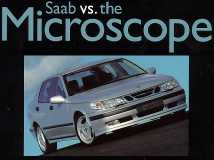 |
 |
 |
 |
 |


 REAL-LIFE SAFETY IS FOUNDATION OF SAAB 9-5's DESIGN
REAL-LIFE SAFETY IS FOUNDATION OF SAAB 9-5's DESIGN
NORCROSS, Ga. - Saab engineers have always regarded occupant safety as one of a car's most important design features. Setting higher safety standards with each new generation Saab, their efforts have culminated in the safety design of the Saab 9-5 - the safest production Saab built to date.
Saab focuses on a Real-life Safety philosophy of designing cars to be as safe as possible in real-world accident situations, rather than just laboratory tests. Since 1972 Saab has investigated more than 5,000 accidents involving Saabs in Sweden. In addition to providing invaluable information regarding the crash safety properties of Saab cars, this data also helps Saab engineers perform more life-like crash tests. The Saab 9-5 has been subjected to more than 40 different crash test configurations, including car-to-car, car-to-truck and car-to-dummy-moose. Of these, only 11 are mandated by government standards.
Front and Rear Triple Load Paths on Each Side
For occupant protection, the front and rear structures of the Saab 9-5
Sedan incorporate three robust load paths on each side of the chassis.
Should a collision occur, these paths distribute crash energy over a broad
area, thereby lessening the force of the impact on the passenger
compartment. Fifty percent of the crash energy is directed through the main
chassis member and 25 percent each through two additional load paths.
"Although it is impossible to predict what type of crash you will have in a frontal impact before it happens," says Mats Fgerhag, manager of the Saab's crash safety center, "we can at least predict how the structure will deform. The more load paths between the point of contact and the rigid safety cage behind it, the easier it is to absorb the energy of the impact."
The safety cage itself is an extremely rigid system of steel members that surround the passenger cabin. The parts likely to be subjected to the highest forces are reinforced by thick, high-tensile steel and all joints are carefully designed to resist tearing.
The rear body structure provides an equally high level of crash protection, thanks to the same kind of reinforcements as the front. A shield around the fuel filler neck is designed to protect it from breaking away, while the tank itself is in the safest possible place, ahead of the rear axle.
Side Impact Protection Utilizes Pendulum B-Pillar
In the event of a side impact, only very limited deformation zones are
available for absorbing the crash energy. The force is absorbed by the side
of the car, where the door pillar is made of high-strength steel, and the
reinforcements in the sill and door pillar assist in distributing the
impact to the safety cage surrounding the interior.
The door pillar of the Saab 9-5 is designed to behave as a pendulum in the event of a side collision. The center section of the "B" pillar is very stiff to prevent the pillar from deforming and intruding into the interior. The top part of the door pillar performs as a "hinge" and retains its position. This system dissipates side-impact crash energy downward, where the human body is stronger and less susceptible to injury. This reduces the risk of injury to the most sensitive parts of the body - the rib cage, head and chest.
Complete Interior Safety System
Complementing the Saab safety cage and pendulum "B" pillar is a complete
interior safety system. The 9-5 Sedan features Saab's head and torso
protecting dual-stage side airbags that are mounted in the outside bolsters
of the front seatbacks. The bottom section of the bag inflates first to
protect the torso, which is the first part of the occupant's body at risk
from side-impact collision forces. Then the top section of the airbag fully
inflates to protect the head.
Additional protection is provided by Saab's force-reducing front seat-belt and pre-tensioner design. All five seating positions incorporate three-point inertia reel seat belts with semi-automatic height adjustments and anti-submarining ramps to prevent the occupant from sliding under the belt in a severe frontal collision. These seat belts provide gentler restraint of the occupant's forward motion to reduce the risk of belt-induced injuries in collisions.
The Saab 9-5 Sedan also features the Saab Active Head Restraint (SAHR) system as standard equipment. This world-first safety feature effectively limits the front seat occupants' head movement during a rear-end collision, reducing the risk of whiplash injury.
In the rear seats, head restraints have been designed to be easily moved to a comfortable position that provides optimal protection. When there are no passengers in the rear seat, the rear head restraints can be lowered to butt against the top of the seat back, further improving the rear view for the driver.
Chassis Design Contributes to Driver Control
Saab's Real-life Safety philosophy dictates that the car provide the driver
with accurate information in an emergency-handling situation. The chassis
of the Saab 9-5 is designed and tuned to ensure the best possible road
safety by following these guidelines:
 |
 |
 |
 |
 |
